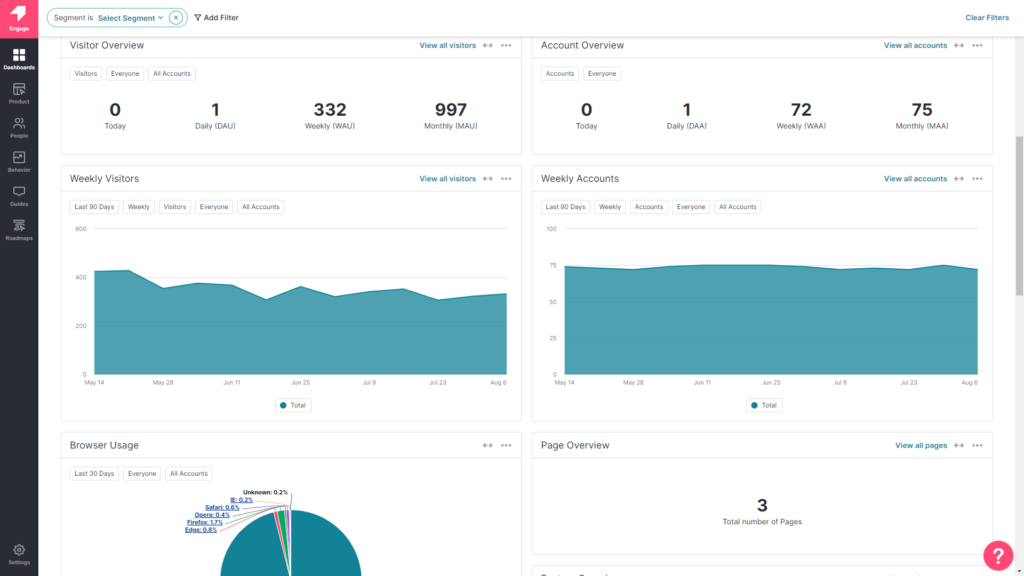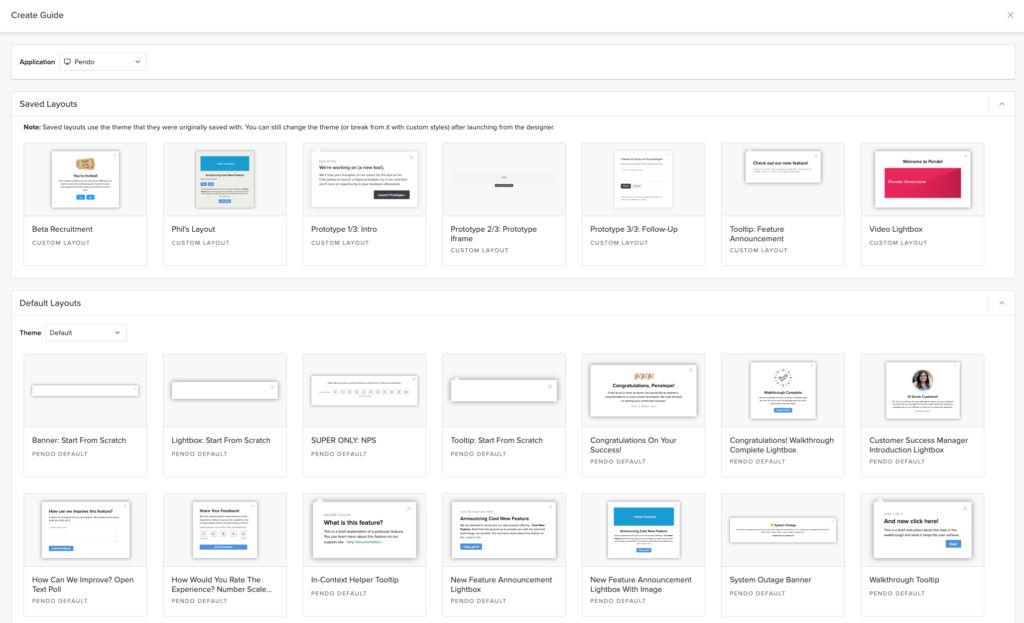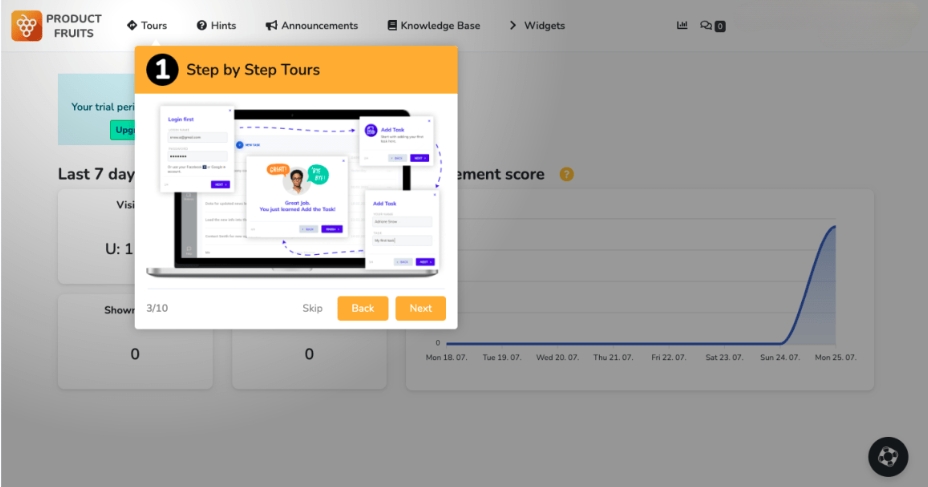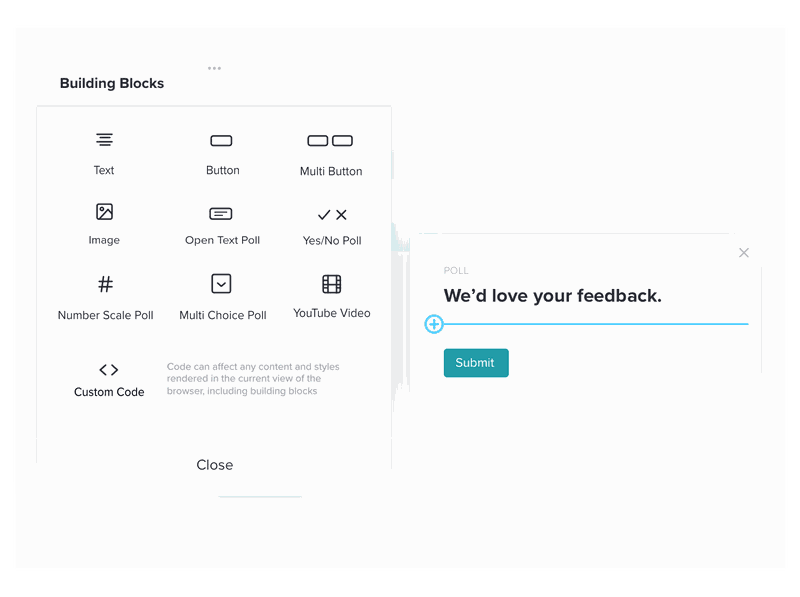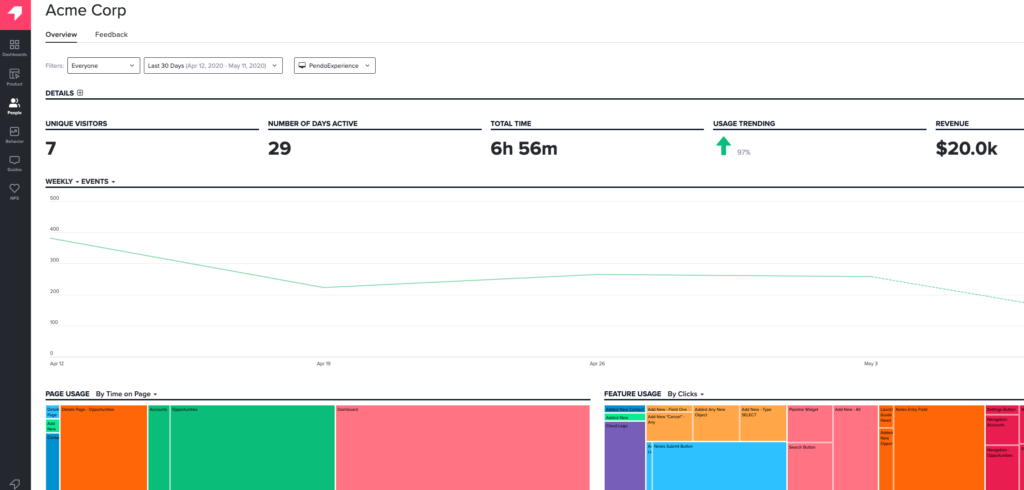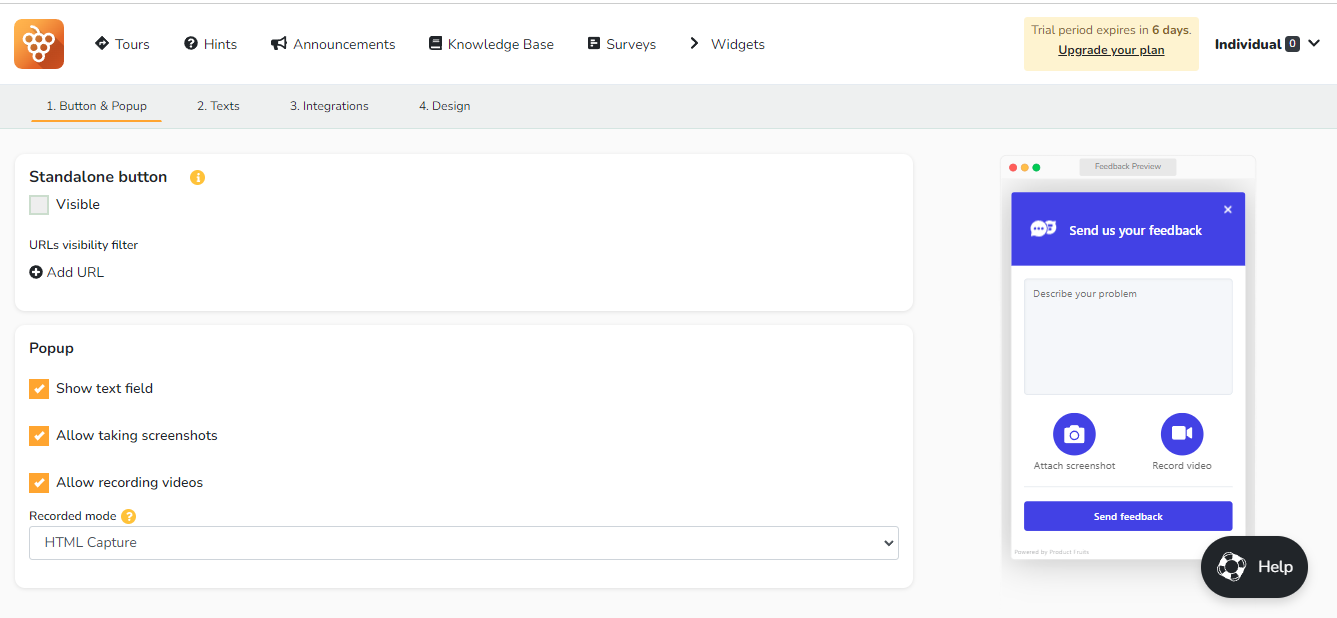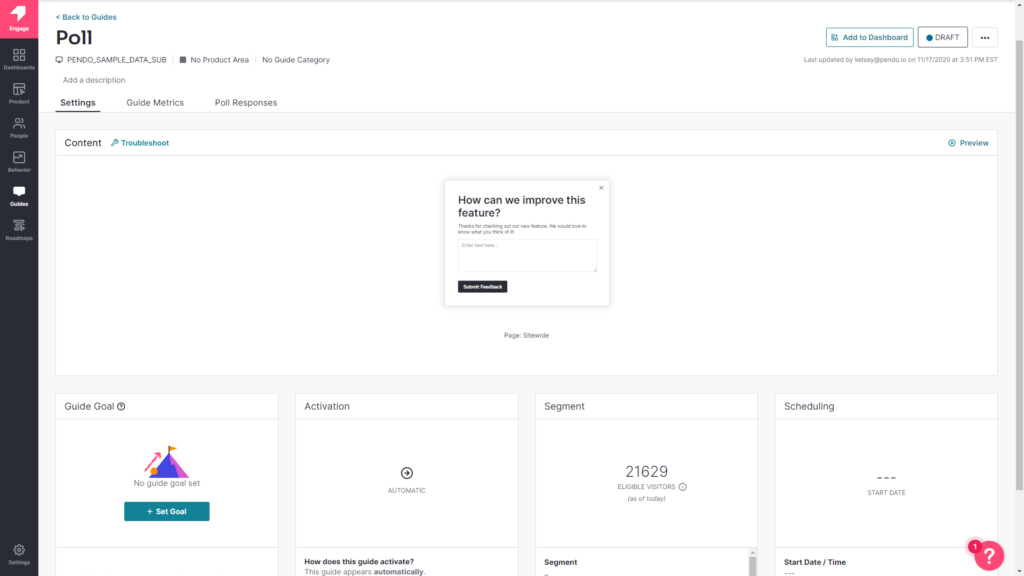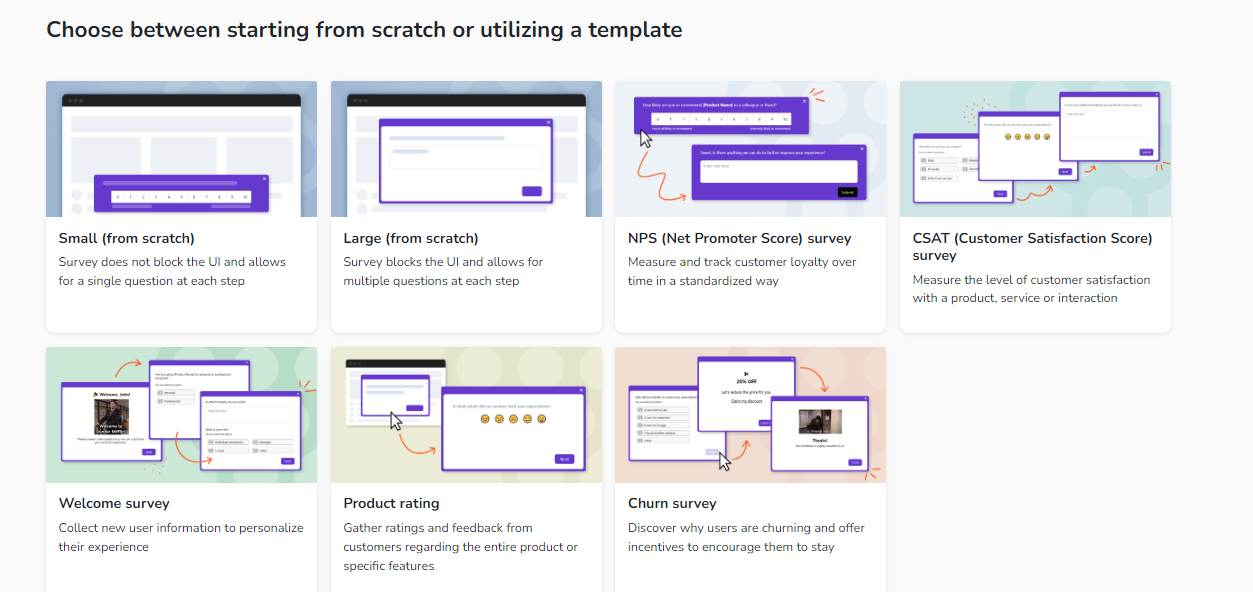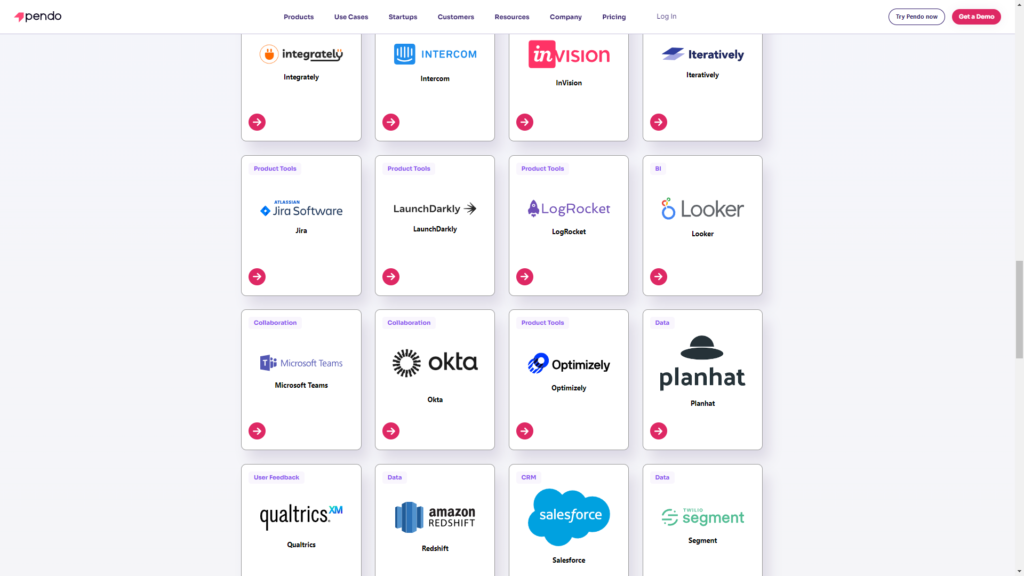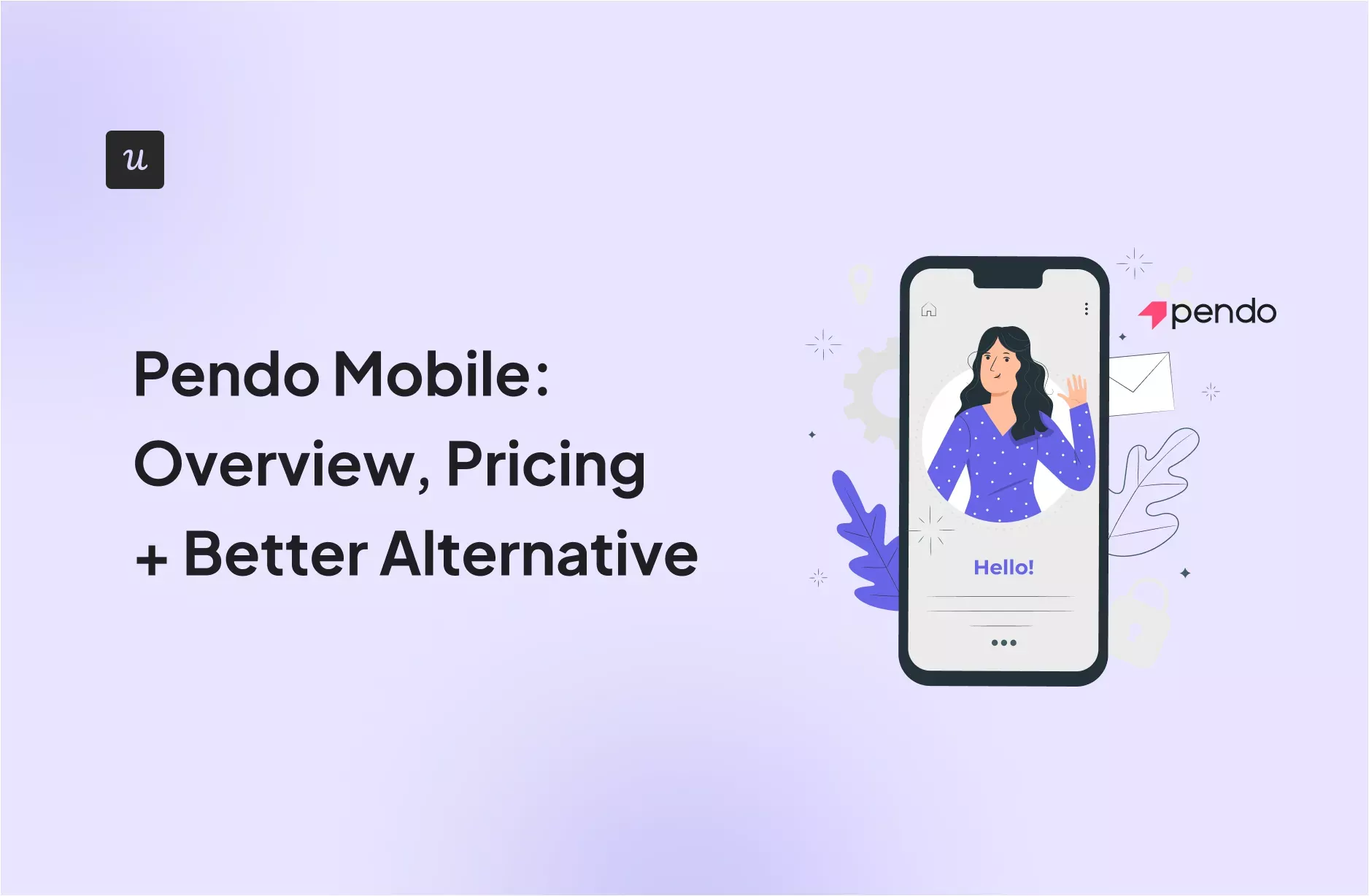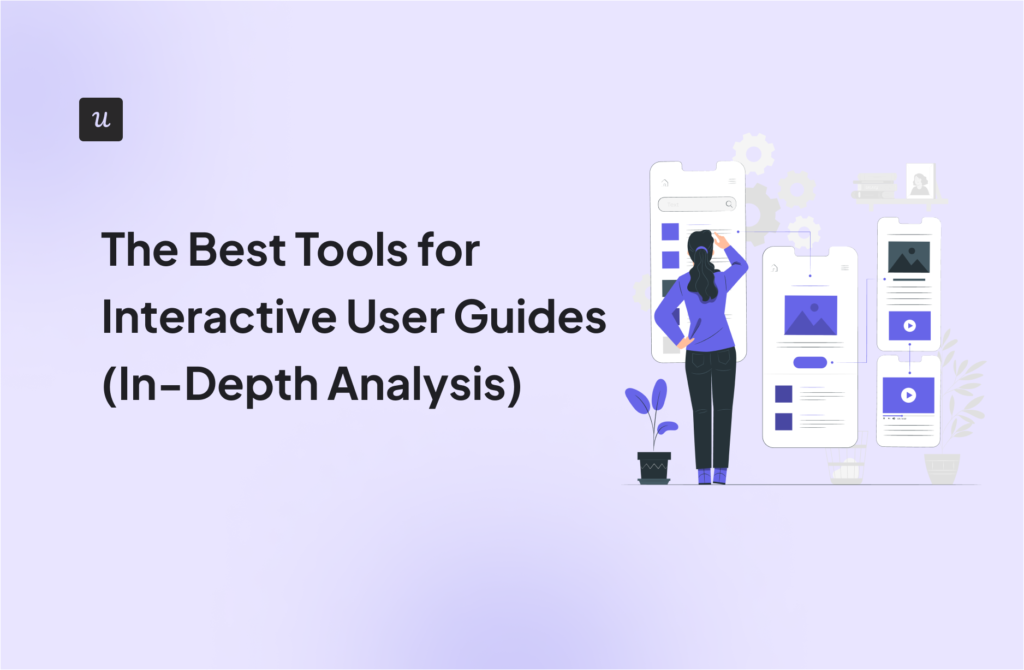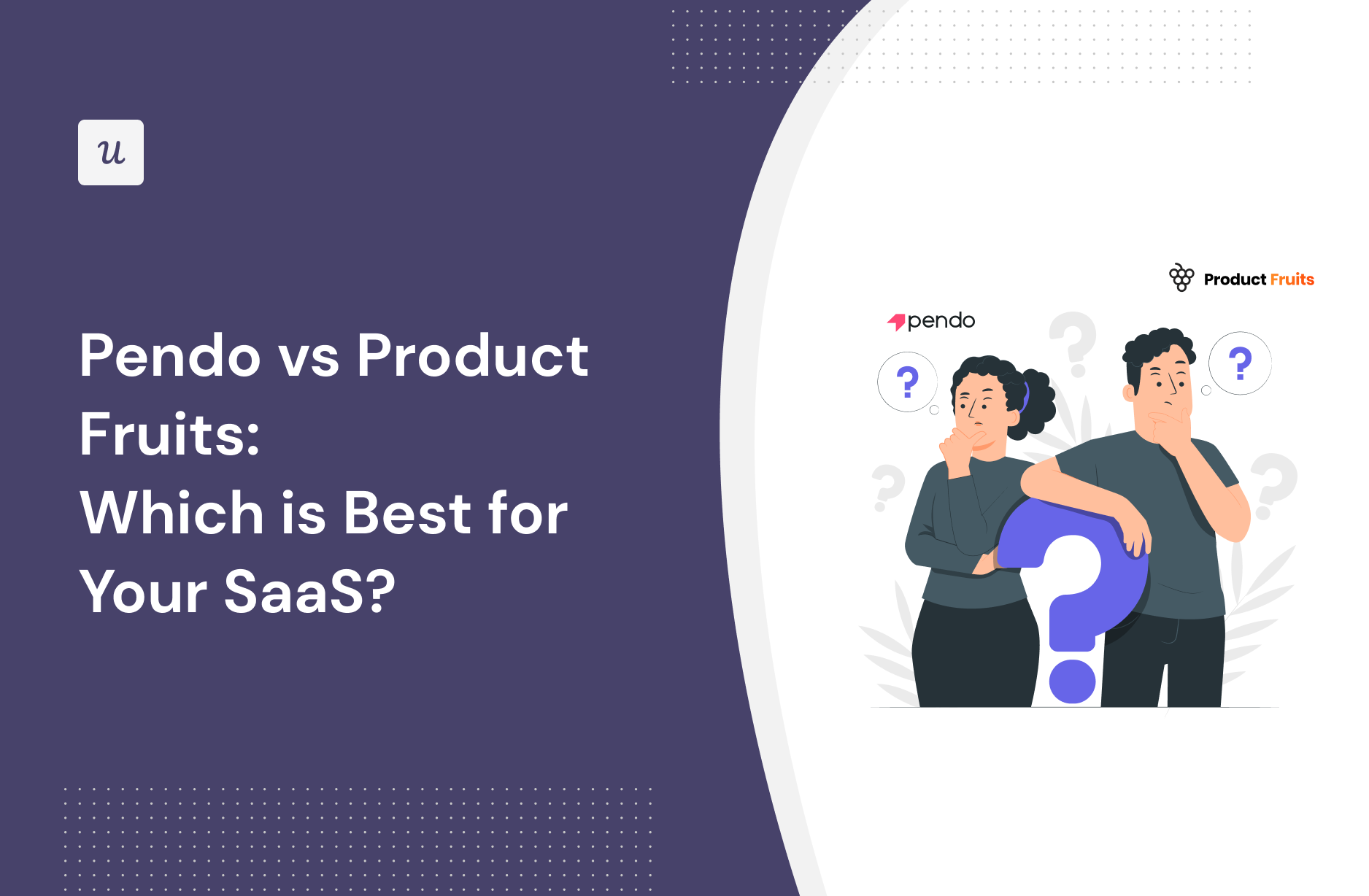
Pendo vs Product Fruits: Which is Best for Your SaaS?20 min read
Wondering whether Pendo or Product Fruits is the best option for your SaaS company?
This article is going to dive into the Pendo vs Product Fruits debate and try to answer a key question: Which is the better tool for user onboarding, as well as other use cases?
In the post below, we’ve covered all the common use cases and done an in-depth analysis of the key features of Pendo and Product Fruits – as well as compared it to an alternative solution that may be better in some situations.
Let’s get into it!
Get The Insights!
The fastest way to learn about Product Growth, Management & Trends.
Overview Pendo vs Product Fruits
- Let’s explore how Pendo, and Product Fruits compare when it comes to user onboarding and other common use cases.
-
- Pendo is a product adoption platform that lets teams monitor product usage, analyze user behavior, and publish in-app guides. The no-code solution focuses on increasing user engagement and driving feature discovery.
- Product Fruits is a platform designed to help you tackle issues related to software adoption. With a focus on seamless customer onboarding, this tool allows companies to create engaging in-app journeys.
-
- If you’re looking for a better option for user onboarding, Userpilot exceeds both functionality and value for money compared to other tools on the list.
- Userpilot is a product growth platform that drives user activation, feature adoption, and expansion revenue. It also helps product teams collect user feedback, streamline onboarding, and gather actionable insights from analytics. Get a Userpilot demo for user onboarding and drive your product growth code-free.
What is Pendo?
Pendo is a product adoption platform that lets teams monitor product usage, analyze user behavior, and publish in-app guides. The no-code solution focuses on increasing user engagement and driving feature discovery.
Additionally, Pendo also lets you survey users, segment customers, and see how many site visitors or MAUs your web app is getting. Certain features like product areas, data explorer, product engagement score, and resource centers are locked to the Starter plan or higher.
What is Product Fruits?
Product Fruits is a platform designed to help you tackle issues related to software adoption. With a focus on seamless customer onboarding, this tool allows companies to create engaging in-app journeys.
The platform provides insights into successful practices, guiding you toward steady business growth. Best of all, you don’t need any coding skills to get started with Product Fruits.
Pendo vs Product Fruits for user onboarding
In this section of the article, we’re really going to compare Pendo vs Product Fruits in terms of user onboarding. That way, we’ll be able to figure out which tool – Pendo or Product Fruits – is the best option depending on your use case.
Pendo for user onboarding
Pendo is a product adoption platform that has the usual onboarding features that are commonly included with similar solutions. However, those using Pendo Free will need to note that they’ll need to find a new onboarding solution once they cross 500 MAUs or upgrade to the paid version.
There are a few ways you can use Pendo to improve your new user onboarding flows:
- Guide Layouts: Pendo has layout templates for lightboxes, banners, and tooltips that you can use to build onboarding flows for new users.
- Flow Triggers: Pendo’s guide activation options let you trigger an onboarding flow when new users land on a particular URL, use a specific device type, interact with a tagged element, or match the target segment.
- Localization Settings: Localization settings can stop an onboarding flow from triggering if it hasn’t been translated into the user’s chosen language. Because Pendo has no AI-powered localization features, you’ll need to upload language CSVs manually for this to work.
- Onboarding Module: You can add the onboarding module to your in-app resource center in two clicks then change the color, text style, and progress icon to align it with your product’s brand palette.
Product Fruits for user onboarding
If you’re looking for a tool to simplify your user onboarding process, Product Fruits can be your go-to. This software teaches your customers the ins and outs of your product. Moreover, its affordability makes it an appealing choice for budget-conscious small startups.
Here’s why Product Fruits can shine in your onboarding toolkit:
- Product Tours: Product Tours are a great way to welcome and introduce new users to your product. With Product Fruits you can craft step-by-step guides and embed videos from YouTube or Vimeo for interactive understanding. You can create cards that highlight your unique selling propositions to generate excitement. Additionally, the tours offer the option for users to initiate further exploration via a hint icon or special button. Want insights of your product tour? use Product Fruits Analytics features. It offers data on user interactions, completion rates, time spent, and more, helping you fine-tune your tours.
- In-app Announcements: Product Fruits uses pop-ups that appear over all other content, ensuring that users will see these messages before product tours. These pop-ups can be utilized for one-time announcements and are considered one of the best ways to share promotional content. Alongside pop-ups, Product Fruits offers a newsfeed feature. It lets you publish updates about your product in various formats. The newsfeed widget can be embedded into your application and will appear when a user clicks on an icon. A common practice is to use a bell icon accompanied by a badge showing the number of unread newsfeed items.
- Knowledge Base: This constitutes a database of information that users can use for assistance at any time. It simplifies article version management, allowing you to create work-in-progress versions and publish updates to production without altering the URL. Moreover, it’s possible to launch your help center on a personalized domain and integrate it into the structure of your website. The Life Ring Button allows users to directly access your web-based application’s knowledge base from anywhere on your product. And the best part? You don’t need any coding to do that.
Pendo vs Product Fruits for product adoption
In this section of the article, we’re really going to compare Pendo vs Product Fruits in terms of product adoption. That way, we’ll be able to figure out which tool – Pendo or Product Fruits – is the best option depending on your use case.
Pendo for product adoption
Because product adoption is the primary use case for the Pendo platform, most of its features contribute towards onboarding users, tracking adoption analytics, monitoring usage patterns, or measuring churn rates.
Pendo’s product adoption features include:
- Product Analytics: Pendo analytics can show you patterns in user behavior, underutilized areas of your product, and other usage data. Pendo divides its analytics into funnels, paths, and retention — the latter of which is capable of tracking cohort churn over time (months or weeks).
- Feature Engagement: Pendo’s dashboard widgets let you see feature engagement from multiple lenses to ensure you get the full picture. You’ll be able to view the features that generate the majority of click volume and track features used by accounts/visitors.
- Build guides to drive engagement: Pendo has layout templates for lightboxes, banners, and tooltips that you can use to build onboarding flows for new users.
- Feedback Collection: Pendo can gather user feedback through polls, input fields, and NPS surveys. Its NPS surveys can be delivered both in-app and via email while giving the option to include follow-up questions that provide qualitative feedback.
Note: Pendo in-app resource centers can only be created if you’re on the Growth or Portfolio plan.
Product Fruits for product adoption
If you’re looking for a tool to simplify your user onboarding process, Product Fruits can be your go-to. This software teaches your customers the ins and outs of your product. Moreover, its affordability makes it an appealing choice for budget-conscious small startups.
Here’s why Product Fruits can shine in your onboarding toolkit:
- Product Tours: Product Tours are a great way to welcome and introduce new users to your product. With Product Fruits you can craft step-by-step guides and embed videos from YouTube or Vimeo for interactive understanding. You can create cards that highlight your unique selling propositions to generate excitement. Additionally, the tours offer the option for users to initiate further exploration via a hint icon or special button. Want insights of your product tour? use Product Fruits Analytics features. It offers data on user interactions, completion rates, time spent, and more, helping you fine-tune your tours.
- In-app Announcements: Product Fruits uses pop-ups that appear over all other content, ensuring that users will see these messages before product tours. These pop-ups can be utilized for one-time announcements and are considered one of the best ways to share promotional content. Alongside pop-ups, Product Fruits offers a newsfeed feature. It lets you publish updates about your product in various formats. The newsfeed widget can be embedded into your application and will appear when a user clicks on an icon. A common practice is to use a bell icon accompanied by a badge showing the number of unread newsfeed items.
- Knowledge Base: This constitutes a database of information that users can use for assistance at any time. It simplifies article version management, allowing you to create work-in-progress versions and publish updates to production without altering the URL. Moreover, it’s possible to launch your help center on a personalized domain and integrate it into the structure of your website. The Life Ring Button allows users to directly access your web-based application’s knowledge base from anywhere on your product. And the best part? You don’t need any coding to do that.
Pendo vs Product Fruits for customer experience
In this section of the article, we’re really going to compare Pendo vs Product Fruits in terms of customer experience. That way, we’ll be able to figure out which tool – Pendo or Product Fruits – is the best option depending on your use case.
Pendo for customer experience
Customer experience is the sum of touchpoints across your customer support, customer success, marketing, and sales teams but the product experience also plays a key role. Pendo lets you survey, poll, and collect feedback from users on the customer experience through multiple features.
Here are the Pendo features that can be used to gather customer experience insights:
- Polling Features: Using Pendo to poll specific segments can guide your customer experience optimization (CXO) efforts. You’ll also be able to add polling widgets to your home dashboard so you can view responses, response rates, and other poll-related data points.
- NPS Surveys: Pendo NPS surveys can collect both quantitative and qualitative data by combining rating scales with follow-up (open-ended) questions. You can view all NPS survey analytics from the NPS section on your sidebar or the NPS widget on your home dashboard. Note: All NPS surveys have Pendo branding on them unless you upgrade to the Starter plan, which costs $7,000/year.
- Segmentation: Pendo segmentation settings like you create different flows, guides, and onboarding journeys for each user. You can segment users based on the type of device they’re on, what operating system it’s running on, which browser they’re using, or when they joined.
- Path Analytics: Pendo’s path analytics dashboard shows you the paths users take to get to a specific page or when coming from a specific page. These insights help you identify the areas where you need to reduce friction and add contextual UI patterns.
- Feedback Module: You can add a feedback module to your in-app resource center in two clicks to get direct insights from users on how to improve the customer experience.
Product Fruits for customer experience
Customer experience is all about ensuring a smooth and hassle-free interaction when using the product or service.
Now, how exactly can Product Fruits ramp up your customer experience?
- Dashboard: This feature enables you to monitor user onboarding progress and critically evaluate your onboarding strategies’ effectiveness.
- Feedback Management: This is a systematic process that involves collecting, tracking, and analyzing customer feedback. Product Fruits does this by offering useful tools like the Adoption Meter and the Feedback Widget to gauge customer sentiments and identify potential issues. You can submit these issues in the form of images or videos. The platform also provides NPS Surveys to assess customer loyalty over time. These insights drive continuous improvements in products and services and enhance the overall customer experience.
- Knowledge Base: This is a collection of helpful information that users can access whenever they need help. You can quickly get to your knowledge base articles through the Life Ring Button or a Hint icon. Moreover, Product Fruits offers an easy-to-use WYSIWYG editor that makes creating content easy.
Pendo vs Product Fruits for user feedback
In this section of the article, we’re really going to compare Pendo vs Product Fruits in terms of user feedback. That way, we’ll be able to figure out which tool – Pendo or Product Fruits – is the best option depending on your use case.
Pendo for user feedback
Product feedback can provide targeted data on the product as a whole or specific features. These will offer insight into which features are easiest/hardest to use, which ones make your product sticky, and which changes to make to keep your largest customers satisfied.
Here are the Pendo features that you can utilize to collect product feedback:
- Customer Effort Score (CES) Polls: CES polls created with Pendo can provide insights on which areas of your product are easiest to use. These CES polls can also target specific segments to see if new users are struggling with a feature that power users have no problem with.
- Mobile Reviews: Those using Pendo for mobile apps can also use its product feedback features to collect reviews for the iOS App Store or Google Play Store. In addition to offering insights, these reviews could also boost user acquisition (provided they’re mostly positive).
- Pendo Feedback: Pendo offers a separate product called Pendo Feedback that can be used to centralize feedback and integrate that data with tools like Salesforce or Jira. Pendo Feedback uses custom pricing and is charged by the seat.
- Segmented Feedback: Pendo feedback lets you see what segment respondents are in, how much they spend, and other relevant user tags so you can highlight responses from your most valuable customers.
Product Fruits for user feedback
Collecting feedback with product tools and enhancing your product based on these insights helps your customers feel acknowledged and valued.
Product Fruit employs these strategies:
- NPS Survey: An easy and consistent method to evaluate and monitor your customers’ loyalty over a period of time.
- Churn Survey: With this survey, you can investigate why users stop using your product. In addition, you can offer rewards to keep them on board.
- CSAT: This feature measures customer satisfaction with a product, service, or interaction. It provides valuable insights into areas that need improvement.
- Product Ratings: Enables user-driven ratings and reviews for the product or specific features. It helps identify the product’s strong and weak points.
If you want more control over your surveys and want to use the results in more detail, you should use Userpilot instead. It allows for more effective feedback collection and instant application of collected data to segment your user base and trigger the right experience.
Pendo vs Product Fruits: Which one you should choose?
To further simplify this selection process, let’s break down the strengths and limitations of each tool. Understanding the distinct advantages and potential drawbacks of Pendo and Product Fruits will provide you with a detailed roadmap for making a well-informed decision!
Pros and cons of Pendo
Pros of Pendo
Let’s take a look at some of the benefits of using Pendo:
- No-Code: Pendo lets you create surveys, in-app guides, and track metrics without needing to write your own code, which saves a lot of time (while making product experiments or split-testing a lot easier).
- Custom Themes: Pendo’s themes let you create multiple palettes and ensure that any in-app materials published align with your existing brand palette (however, you can only create/customize themes after you’ve installed the Pendo snippet).
- Flexible Dashboards: Pendo has plenty of widgets that you can add to your dashboard, including feature adoption, net promoter score, poll results, guide engagement, product stickiness, and MAUs — so you always have your most important metrics within reach.
- Integrations: Pendo has 50 different integrations to choose from including popular tools like Intercom, Jira, Okta, and HubSpot. Unfortunately, only four of these — Salesforce, Segment, Workato, and Zendesk — are two-way integrations that can share data both ways.
- Multi-Platform Analytics: Because Pendo is compatible with mobile applications, you’ll be able to track product analytics for both web apps and mobile apps. This gives you a more holistic view of how users (or specific segments) use your product on different platforms. Note: You’ll need to upgrade to Pendo Portfolio to add more than one product to your account.
Cons of Pendo
While Pendo certainly has quite a few benefits that make it an appealing solution, there are also a few notable drawbacks that you should be aware of before you choose the platform as your product adoption tool:
- Pricing Jumps: While Pendo does offer a free version, it has a limit of 500 MAUs. Upon reaching the MAU limit, you’ll need to upgrade to continue using most of Pendo’s features (and paid plans tend to cost thousands of dollars per month).
- Locked Features: Key features like the data explorer, resource center, and product engagement score are locked behind the Growth or Portfolio plan.
- Data Lag: Pendo’s analytics dashboards only update once per hour. In some cases, this data lag could lead product teams to make the wrong decisions or draw false conclusions from outdated insights.
Pros and cons of Product Fruits
Pros of Product Fruits
Product Fruits offers many benefits with its easy-to-use, no-code platform. It is one of the good solutions for companies looking for affordable user onboarding, product adoption, and product analytics.
So, what does Product Fruits bring to the table? Let’s explore its promising pros:
- Guided Product Tours: It guides users to learn about your app through step-by-step tours for new features.
- Newsfeed: Enhance your users’ connectivity by sharing updates about your product. Additionally, you can set specific newsfeed items which will be displayed in the knowledge base.
- Feedback Through Screenshots and Videos: This feature allows users to send screenshots or videos directly within the app to provide feedback.
- Tooltips: These are brief hints added to different parts of the application to guide users and prevent confusion
- Life Ring Button: A comprehensive support hub that combines all guidance and support resources in one location. This allows users to conveniently access onboarding flows, support documents, and tutorials, no matter what page they’re on.
- Custom Events: Trigger actions based on what users do in your app for more personal interaction.
- Segmentation: Create unique experiences for different types of users and show tailored content to separate user groups.
- Analytics: Gain valuable insights into user behavior, identify improvement areas, and address pain points effectively.
- AI Writer: This feature instantly generates your onboarding copy. However, it is only available in higher-tier plans.
Cons of Product Fruits
While Product Fruits does have its merits, it’s not without its share of issues. Let’s see some potential drawbacks that might have you considering alternatives.
- Absence of A/B Testing: Product Fruits lacks A/B testing, a vital feature for refining your product tours based on user responses and data-backed insights.
- Basic Analytics: Product Fruits does not offer in-depth analytics as its competitors like Userpilot. This makes it difficult to evaluate user interaction and the success of your onboarding
- Insufficient Segmentation Options: The segmentation options here are only based on user attributes. This means you can’t highlight particular app functions or experiences based on a user’s past actions in your app, which can limit the customization of their experience.
- Missing Event-Based Triggering: The absence of real-time triggers may limit timely content delivery. This could affect the success of all in-app flows, such as product tours, tooltips, walkthroughs, modals, etc.
- Complex Tour Configuration: Configuring tours with specific conditions, especially when tuning CSS selectors, can be challenging and time-consuming.
- Limited Integrations: This tool links up with analytic tools, which is great. However, it doesn’t go beyond that. You won’t be able to bring in your resource center materials or link up your CRM unless you’re a Hubspot user.
Userpilot – A better alternative for your SaaS
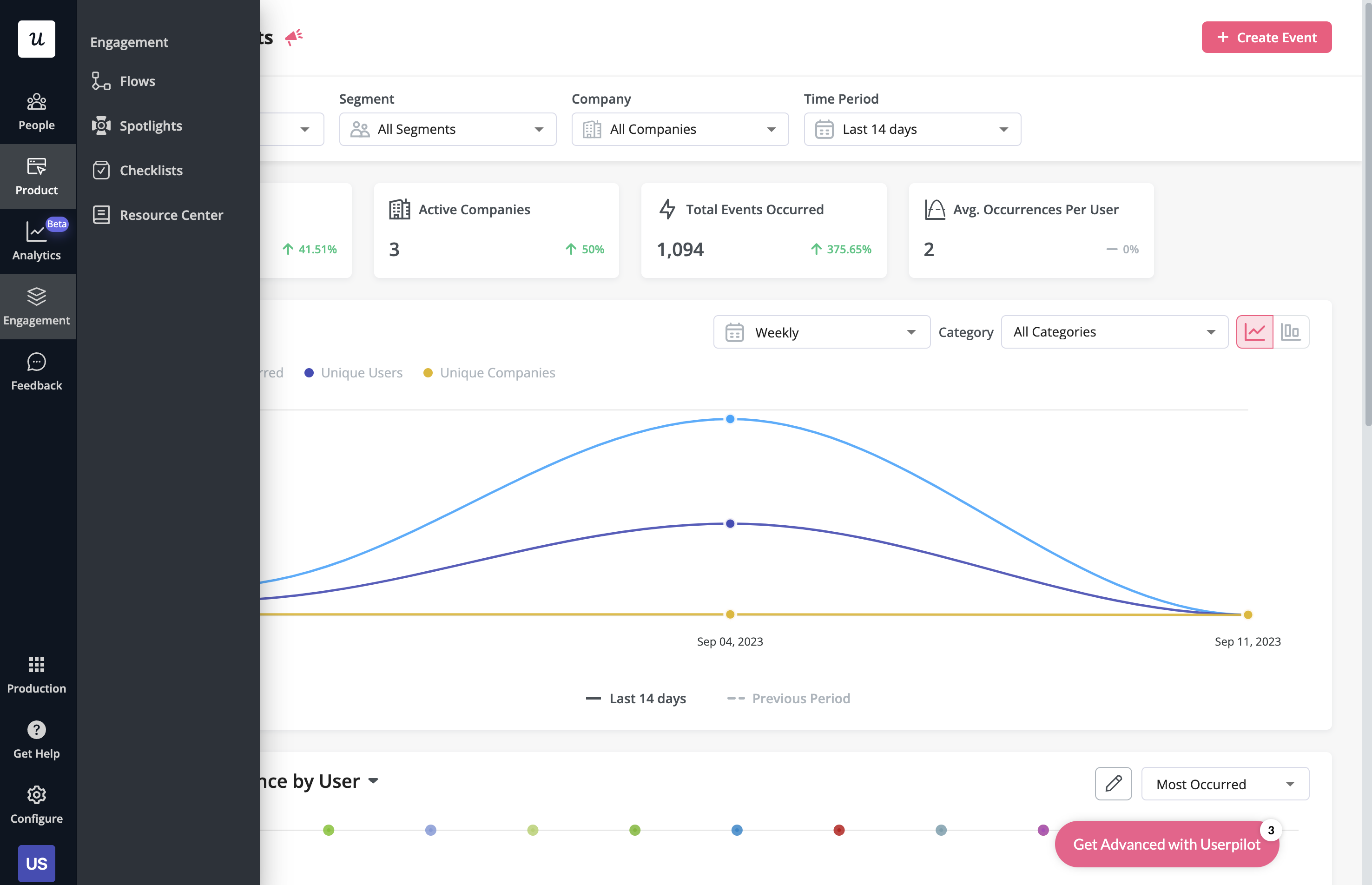
With Userpilot, you’ll be able to track both product usage and user behavior to get a holistic view of how customers use your product — which will guide future development, improve the user experience, and inform your growth efforts.
Pros of Userpilot
As a full-suite digital adoption platform, Userpilot has all the features you need to onboard users, track analytics, and gather feedback from customers without writing a single line of code. Here are a few pros of using Userpilot as your product growth solution:
- No-code builder: Userpilot’s Chrome extension lets you build flows, add UI elements, and tag features without writing a single line of code.
- UI patterns: There are plenty of UI patterns to choose from when using Userpilot, such as hotspots, tooltips, banners, slideouts, modals, and more!
- Startup-friendly: Userpilot’s entry-level plan gives you access to all available UI patterns so you can hit the ground running.
- Walkthroughs and flows: Build engaging interactive walkthroughs and personalized onboarding flows that target specific segments of your user base.
- Self-service support: Build an in-app resource center to help users solve problems, customize its appearance to align it with your brand, and insert various types of content (videos, flows, or chatbots) to keep your customers satisfied.
- A/B testing: Userpilot’s built-in A/B testing capabilities will help you split-test flows, iterate on the best-performing variants, and continually optimize based on user behavior.
- Feedback collection: Userpilot has built-in NPS surveys with its own unified analytics dashboard and response tagging to help you retarget users. There are other survey types to choose from and you can even create your own custom survey.
- Survey templates: There are 14 survey templates to choose from so you can gather feedback on specific features or run customer satisfaction benchmarking surveys like CSAT and CES.
- Advanced analytics: Userpilot lets you analyze product usage data, monitor engagement on all in-app flows, and use the data to create user segments that are based on behaviors instead of demographics.
- Event tracking: Userpilot’s no-code event tracking lets you tag UI interactions (hovers, clicks, or form fills) and group them into a custom event that reflects feature usage.
- Third-party integrations: Userpilot has built-in integrations with tools like Amplitude, Mixpanel, Kissmetrics, Segment, Heap, HubSpot, Intercom, Google Analytics, and Google Tag Manager so you can share data between all the solutions in your tech stack.
Cons of Userpilot
Of course, no tool is perfect and there are a few cons to consider before choosing Userpilot as your user onboarding or product growth solution:
- Employee onboarding: Currently, Userpilot only supports in-app customer onboarding.
- Mobile apps: Userpilot doesn’t have any mobile compatibility which could make it difficult for developers with cross-platform applications to create a consistent user experience for both versions of their product.
- Freemium plan: There’s no freemium Userpilot plan so those bootstrapping their startup and need sub-$100 solutions should consider more affordable onboarding platforms like UserGuiding or Product Fruits.
Conclusion
Hopefully, this post helped you decide whether Pendo or Product Fruits is more appropriate for your company. As you can see – both have many upsides and downsides.
Undeniably, Userpilot provides a better value for money and is a better choice for a mid-market SaaS, especially when it comes to user onboarding and user feedback.
If you’re interested in finding more, book a demo with our team here!
Try Userpilot – the Best User Onboarding Solution for SaaS


